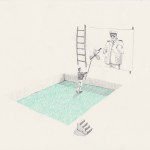In July issue of The Brooklyn Rail, I wrote about an Imi Knoebel installation at Dia:Beacon. The installation, billed as a restoration of Knoebel’s 1977 project “24 Colors–For Blinky,” was in fact a wholesale recreation of the enormous project. Preservation and restoration of Minimalist art is the subject of a small show currently on view at the Guggenheim, �Imageless: The Scientific Study and Experimental Treatment of an Ad Reinhardt Black Painting.� In 2001 AXA Art Insurance donated “Black Painting”(1960-1966), an irreparably damaged Ad Reinhardt piece, as part of a conservation research study and collaboration with The Museum of Modern Art. Over the next five years, conservators, scientists, curators, and artists carried out a complete physical examination and scientific analysis of the work, which grew into a dossier of information about Reinhardt�s working methods and subsequent experimental restoration techniques used on the painting.
In the NY Times, Holland Cotter reports that Reinhardt, when he was alive, made himself readily available to repair paintings, or substitute fresh ones if necessary. “When he offered to replace a damaged black painting in the Museum of Modern Art�s collection, curators balked. But we want our painting, they said. So battles over authenticity � over what constituted an original Reinhardt, or a particular Reinhardt, or an imperfect-but-acceptable Reinhardt � began during his lifetime and have grown knottier since. The Guggenheim�s black painting is painful evidence of these wars: it is not just seriously battle-scarred, it is a ruin, a reject, not-art. Having acquired it in that parlous condition, bruised and overpainted, AXA was initially planning to warehouse it. Instead it gave the picture to the Guggenheim, not as an exhibitable work of art, but as an object for study and experimentation. The gesture was the equivalent of donating a body to science; dissection, not resurrection, was the goal.” I wonder if the curators at Dia were as thoughtful when they chose recreation over restoration for Knoebel’s project.
�Imageless: The Scientific Study and Experimental Treatment of an Ad Reinhardt Black Painting,” organized by Carol Stringari. Guggenheim Museum, New York, NY. Through September 14.















Sharon,
This is an interesting twin topic. I haven’t seen the Knoebels at Dia, but yesterday I saw the informative show at the Guggenheim, which includes the “body,” images of microscopic analysis, and a terrific video on the tests done with lasers in Greece and The Netherlands.
A show in the small adjacent gallery contains several Reinhardts.
These are issues–longevity, fragility, conservation– we all should be thinking about for our own work, too.
If you’re interested in hearing more background information about the “Imageless” exhibition and the science behind their restoration of the Black Painting, I recommend listening to the New York Academy of Sciences’ Podcast about “Imageless.” It features Carol Stringari, the Chief Conservator at the Guggenheim. You can listen to that here.